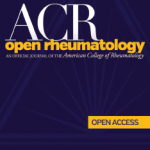Besides that, I am working with teams from the ACR and Wiley to update the website and highlighting papers in a newsletter that comes out with each journal. Each highlight includes a blurb summarizing the paper, and the author reviews it before it goes live.
We also have a social media presence, so the highlights are also published there. In addition, we are asking authors to prepare a digital, or even video, abstract of their study that is social media friendly, so it can appear there as well. The ACR’s digital content director, Brian Robinson, has expanded our social media presence to the new and rapidly growing Bluesky platform.
We have a fantastic supporting team in [ACR employees] Maggie Parry and Chris Reynolds, and [Wiley employee] Adam Mlodzinski.
TR: Is anything else in the works for ACROR?
Dr. Perl: Of course, we are always seeking to improve the quality of the articles and continually enhance the impact factor of the journal. At present, our papers do not include the massive datasets that are expected in very high-impact journals. So I am working to attract papers that have larger datasets and are of higher caliber. I have been talking to researchers about that, and we are already getting some very good submissions. The future of the journal looks good.
TR: In terms of the papers submitted, are you seeing any trends, perhaps incorporating artificial intelligence (AI)?
Dr. Perl: One trend is AI-created datasets. I am also reviewing for other journals, and many are getting paper submissions that smell like they are created by AI. In other words, it is hard to determine if they have real and new information in them, or [if these papers] are basically just re-mined, existing data.
These AI-created datasets are often impenetrable. I am personally not in favor of publishing those articles and instead favor hypothesis-driven research that is validated in experiments.
So, in summary, yes, AI-created datasets can find something that is new and interesting, but I think that any hypothesis needs to be validated under sound experimental conditions, which may be a clinical trial or an animal or cell-line model. That is my personal view. It’s hard to appreciate the veracity of those papers that come out of these purely dataset analysis or so-called dry lab studies—and there are many of them out there now.
TR: A lot goes into being the editor in chief of a journal, between staying on top of trends in research, changes in clinical care and just reaching the journal’s audience today given the demands on their time and the growing clutter of the information age. Why did you decide to take on a five-year term as ACROR editor in chief?



